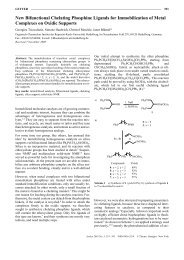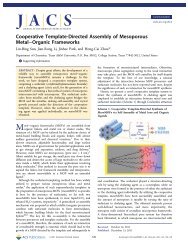Singlet Fission - Department of Chemistry
Singlet Fission - Department of Chemistry
Singlet Fission - Department of Chemistry
Create successful ePaper yourself
Turn your PDF publications into a flip-book with our unique Google optimized e-Paper software.
X Chemical Reviews, XXXX, Vol. xxx, No. xx Smith and Michl<br />
Table 4. Diffusion Coefficients in the ab Plane (Dab) and in the c<br />
Direction (Dc) and In-Plane (Ψin) and Out-<strong>of</strong>-Plane (Ψout)<br />
Hopping Rates<br />
compd. ref Dab/cm 2 s -1 Dc/cm 2 s -1 Ψin/s -1 Ψout/s -1<br />
2 85 b 4 × 10 -3 10 -6 6 × 10 12 6 × 10 7<br />
2 85 b 4 × 10 -4 2 × 10 -6 7 × 10 11 10 8<br />
2 85 b 6 × 10 -5 10 -7 10 11 10 7<br />
2 101 5.3 × 10 -5 1.31 × 10 10 6 × 10 6<br />
2 143 a 4.8 × 10 -2<br />
2 146 2 × 10 -3<br />
2 161 c 4 × 10 -3<br />
2 162 3.3 × 10 -3<br />
a Value for Dab was extrapolated to infinite temperature. b Several<br />
sets <strong>of</strong> parameters were tried. c This value was calculated for the b<br />
direction and may be viewed as a lower limit for Dab. We suspect that<br />
it is the most reliable <strong>of</strong> the results reported.<br />
In perusing the old literature on singlet fission in 2, the<br />
reader needs to be aware <strong>of</strong> two potential pitfalls. The first<br />
is minor, in that different authors favor different units for<br />
first-order rate constants. Some use s -1 whereas others use<br />
cm 3 s -1 , and the two are related by the density <strong>of</strong> molecules<br />
<strong>of</strong> 2 in its crystal, 3.37 × 10 21 cm -3 . 155 We have converted<br />
all results to s -1 . The second complication is more serious,<br />
in that most <strong>of</strong> the published rate constants have been derived<br />
using the approximate Johnson-Merrifield theory 17 and their<br />
absolute values need to be taken with a large grain <strong>of</strong> salt<br />
(section 2.1). Strictly speaking, the rate constants k-1 and k2<br />
defined in eq 2 do not have separate significance and only<br />
their ratio ε ) k2/k-1 is meaningful. The inadequacy <strong>of</strong> the<br />
Johnson-Merrifield model for a quantitative description is<br />
perhaps best illustrated by noting 90 that it permits a fit <strong>of</strong><br />
the dependence <strong>of</strong> fluorescence intensity <strong>of</strong> 2 on the<br />
orientation <strong>of</strong> a static magnetic field both in the presence<br />
and in the absence <strong>of</strong> microwave radiation, but the resulting<br />
rate constants k-1 differ by an order <strong>of</strong> magnitude. Even<br />
fitting to the more accurate Suna model 18 requires assumptions<br />
that lead to considerable uncertainties. The widely<br />
varying published values <strong>of</strong> singlet fission rate constants<br />
(Table 3) clearly represent no more than order-<strong>of</strong>-magnitude<br />
estimates. The most recent directly measured S1 lifetimes<br />
favor the higher values among the previously reported rates.<br />
The spread in the values <strong>of</strong> the diffusion coefficients<br />
<strong>of</strong> triplet exciton determined for 2 by various methods is<br />
huge (Table 4). Even though the numerical values <strong>of</strong><br />
parameters derived from fitting to approximate models are<br />
<strong>of</strong> limited utility, it seemed worthwhile to summarize the<br />
results because there is no reason to question the underlying<br />
experimental data.<br />
Thermally Activated <strong>Singlet</strong> <strong>Fission</strong>. An activation<br />
barrier to fission is expected, since the process is slightly<br />
endoergic. The best determination <strong>of</strong> the endoergicity probably<br />
is the observation <strong>of</strong> the 0-0 transition <strong>of</strong> S0 f T1<br />
excitation at 1.25 eV and that <strong>of</strong> S1 f S0 emission at 2.32<br />
eV, yielding 0.18 eV for the activation energy. 103 Other<br />
determinations <strong>of</strong> the 2E(T1) - E(S1) energy that appear<br />
reliable range from 0.15 to 0.24 eV 14,78,85,103,104,152,162 (additional<br />
old values <strong>of</strong> activation energy for fluorescence<br />
quenching are 0.02 156 and 0.10 157 eV). Above 160 K, this<br />
energy barrier can be overcome thermally fast enough for<br />
fission to compete successfully with fluorescence, and at<br />
room temperature, fission is believed to be the fate <strong>of</strong> nearly<br />
all singlet excitons. This accounts for the low roomtemperature<br />
fluorescence quantum yield <strong>of</strong> crystalline 2<br />
(0.002) 158 compared with 1 (0.95). 131 A much higher value<br />
<strong>of</strong> room-temperature fluorescence quantum yield (0.15) was<br />
reported more recently by one set <strong>of</strong> authors, 153 possibly<br />
because they were investigating another crystal form, but<br />
the results may be unreliable since one <strong>of</strong> the authors was<br />
subsequently shown to have falsified a large amount <strong>of</strong> other<br />
experimental data. 159<br />
Fluorescence. The fluorescence <strong>of</strong> single crystals <strong>of</strong> 2 has<br />
been investigated by many authors. With ps pulsed laser<br />
excitation, a fluorescence rise time <strong>of</strong> 12 ps and decay time<br />
<strong>of</strong> 145 ps were found. 143 From the fluorescence decay time,<br />
the fission rate constant was calculated to be 5.7 × 10 9 s -1<br />
at 300 K and 1.7 × 10 13 s -1 at infinite temperature. From<br />
the latter, the hopping rate in the ab plane is 10 13 s -1 , and<br />
the diffusion coefficient for the ab plane (Dab, “in-plane”) is<br />
4.8 × 10 -2 cm 2 s -1 , ∼100 times larger than for the c direction<br />
(Dc, “out-<strong>of</strong>-plane”). The diffusion <strong>of</strong> triplet excitons is<br />
known to be highly anisotropic, and Dab has been variously<br />
reported to be 100-4000 times larger than Dc. 35,85,143 These<br />
rates are important for the description <strong>of</strong> singlet fission by<br />
the Suna model. 18<br />
Using less intense synchrotron radiation, biexponential decay<br />
was observed. 160 The fast component was fitted to a lifetime<br />
<strong>of</strong> 0.2 ns and is consistent with other measurements. 143-145<br />
The slow component had a lifetime <strong>of</strong> 1.7 ns and was later 37<br />
attributed to a slow decay <strong>of</strong> triplet exciton pairs. The<br />
authors 160 argued convincingly that a previously reported<br />
even slower component <strong>of</strong> fluorescence with a 10-14 ns<br />
lifetime observed at 77 K 144 and 100-300 K 145 was an<br />
artifact due to nonlinear effects caused by high laser<br />
excitation intensity (the original attribution was to emission<br />
from a second level separated by 0.05 eV, 145 perhaps due to<br />
a different crystalline form at grain boundaries, or a<br />
monomer-like and a dimer-like form within the crystal). The<br />
fast fluorescence decay obtained with synchrotron radiation 160<br />
was later fitted 37 to the Suna diffusion model, 18 taking into<br />
account the possibility <strong>of</strong> fusion <strong>of</strong> triplet exciton pairs into<br />
a singlet exciton. The fit yielded an in-plane hopping rate<br />
(Ψin) <strong>of</strong>2× 10 11 s -1 , an out-<strong>of</strong>-plane hopping rate (Ψout) <strong>of</strong><br />
2.8 × 10 9 s -1 , and a fission rate constant <strong>of</strong> 6.7 × 10 9 s -1 .<br />
A later study <strong>of</strong> fluorescence decay in 2 using a series <strong>of</strong><br />
excitation densities separated the effects due to singlet exciton<br />
annihilation. 146 The singlet exciton lifetime was 300 ps at<br />
293 K. No slow component was observable in single crystals<br />
<strong>of</strong> 2 (


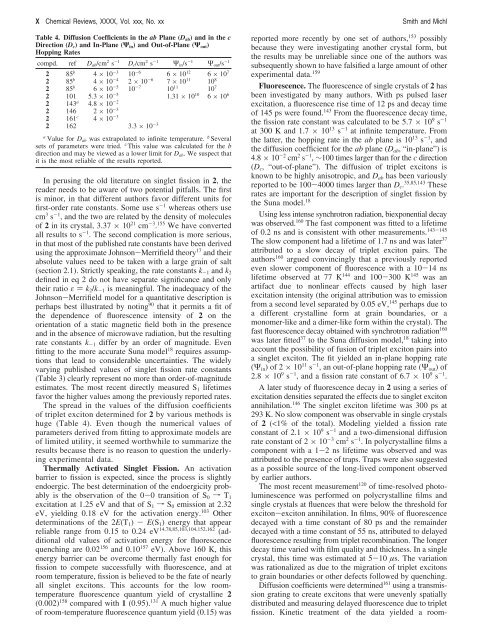
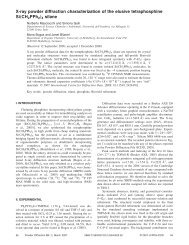
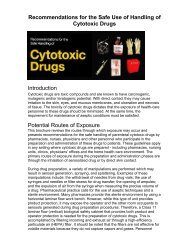
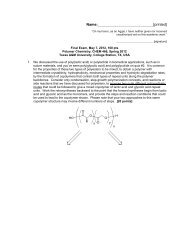

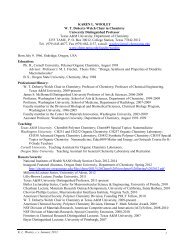
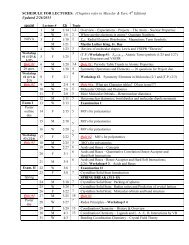
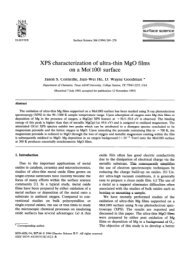
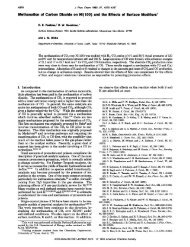
![Radical salts of TTF derivatives with the metal–metal bonded [Re2Cl8]](https://img.yumpu.com/10115211/1/190x253/radical-salts-of-ttf-derivatives-with-the-metal-metal-bonded-re2cl8.jpg?quality=85)



